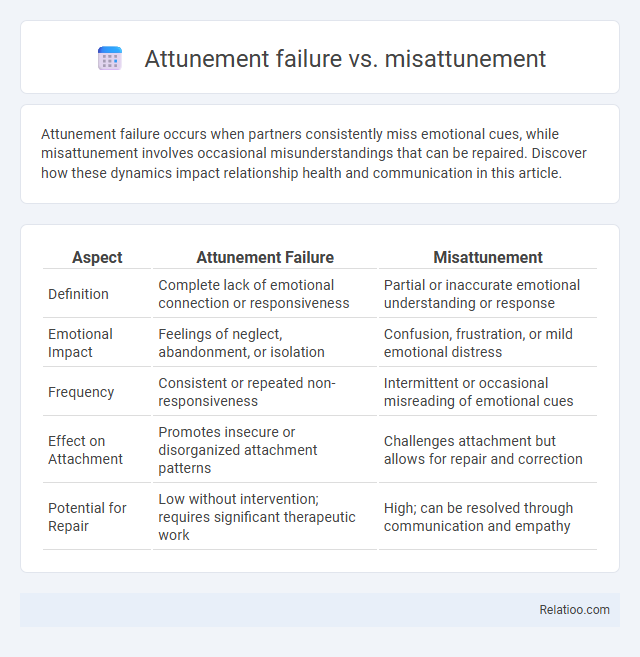Attunement failure occurs when partners consistently miss emotional cues, while misattunement involves occasional misunderstandings that can be repaired. Discover how these dynamics impact relationship health and communication in this article.
Table of Comparison
| Aspect | Attunement Failure | Misattunement |
|---|---|---|
| Definition | Complete lack of emotional connection or responsiveness | Partial or inaccurate emotional understanding or response |
| Emotional Impact | Feelings of neglect, abandonment, or isolation | Confusion, frustration, or mild emotional distress |
| Frequency | Consistent or repeated non-responsiveness | Intermittent or occasional misreading of emotional cues |
| Effect on Attachment | Promotes insecure or disorganized attachment patterns | Challenges attachment but allows for repair and correction |
| Potential for Repair | Low without intervention; requires significant therapeutic work | High; can be resolved through communication and empathy |
Understanding Attunement: Definition and Importance
Attunement failure occurs when a caregiver consistently misses or misunderstands a child's emotional signals, leading to a disruption in emotional bonding and development. Misattunement refers to occasional mismatches in emotional responses that, when corrected, help the child learn emotional regulation and resilience. Understanding these distinctions is crucial for Your ability to foster secure attachments and promote healthy emotional growth in relationships.
What is Attunement Failure?
Attunement failure occurs when a caregiver consistently misreads or ignores a child's emotional cues, leading to a lack of emotional connection and support. Misattunement refers to moments when the caregiver's responses are out of sync with the child's needs but can be corrected through repair and re-engagement. Unlike misattunement, attunement failure represents a persistent pattern that disrupts healthy emotional development and attachment security.
Exploring Misattunement: Key Characteristics
Misattunement occurs when there is a partial or inaccurate alignment between individuals' emotional states, leading to misunderstandings or unmet emotional needs that disrupt effective communication. Unlike outright attunement failure, which reflects a complete breakdown in emotional connection, misattunement involves subtle inconsistencies that can accumulate over time, impacting relationship quality. Key characteristics include misinterpretation of cues, delayed responses, and emotional incongruence, often requiring intentional recalibration to restore relational harmony.
Attunement Failure vs Misattunement: Core Differences
Attunement failure occurs when a caregiver consistently misses or completely misunderstands a child's emotional cues, leading to a lack of emotional connection, whereas misattunement involves occasional inaccuracies or mismatches in responding, often followed by repair attempts that help restore connection. You experience attunement failure as a persistent breakdown in emotional synchrony that can hinder secure attachment development, while misattunement is more common and can be corrective, supporting emotional growth. Understanding these core differences highlights the importance of timely emotional responsiveness in fostering healthy relationships.
Psychological Impact of Attunement Failures
Attunement failure occurs when a caregiver or individual fails to accurately perceive and respond to another's emotional needs, leading to feelings of disconnect and insecurity. Misattunement involves responses that are inconsistent or mismatched to the individual's emotional state, potentially causing confusion and emotional distress over time. The psychological impact of attunement failures includes impaired emotional regulation, increased risk of attachment disorders, and difficulties in developing trust and empathy within relationships.
The Emotional Consequences of Misattunement
Misattunement occurs when your emotional signals are misunderstood or ignored, leading to feelings of disconnection and frustration in relationships. Unlike attunement failure, which implies a complete inability to connect emotionally, misattunement involves subtle inconsistencies that disrupt emotional synchronization. These disruptions can cause emotional consequences such as increased anxiety, diminished trust, and impaired emotional regulation, ultimately affecting your ability to form secure attachments.
Root Causes of Attunement Failure
Root causes of attunement failure primarily stem from emotional unavailability, unresolved trauma, and miscommunication between caregiver and child, disrupting the emotional connection essential for healthy development. Misattunement occurs when responses are inaccurate or mismatched, leading to confusion but not a complete breakdown of connection, while attunement failure signifies persistent and pervasive breakdowns in emotional synchronization. Chronic stress, caregiver mental health issues, and environmental instability often underlie these failures, impairing the caregiver's ability to respond sensitively to the child's emotional needs.
Common Examples of Misattunement in Relationships
Common examples of misattunement in relationships include inconsistent emotional responses, such as a partner dismissing or minimizing feelings, which leads to confusion and emotional distance. Another frequent instance is misreading nonverbal cues, resulting in misunderstandings and unmet needs. These patterns disrupt effective attunement, causing attunement failure and weakening the relational bond.
Strategies to Repair Attunement Failures
Attunement failure occurs when a caregiver inaccurately reads or responds to a child's emotional cues, leading to disconnection and distress, whereas misattunement involves momentary mismatches that can be repaired through sensitive adjustment. Strategies to repair attunement failures emphasize empathetic listening, validating the child's feelings, and consistent, responsive interactions that rebuild trust and emotional regulation. Therapeutic approaches like emotionally focused therapy (EFT) and mindful parenting techniques enhance caregivers' awareness and responsiveness, promoting secure attachment and emotional resilience.
Building Resilient Connections: Beyond Misattunement
Attunement failure, misattunement, and attunement failure all impact the quality of interpersonal connections, with misattunement referring to temporary mismatches in emotional understanding and attunement failure indicating prolonged or repeated lapses in emotional responsiveness. Building resilient connections requires recognizing these patterns and actively repairing communication breakdowns to foster trust and empathy. Your ability to move beyond misattunement strengthens relational resilience and promotes deeper emotional bonds.

Infographic: Attunement failure vs Misattunement
 relatioo.com
relatioo.com